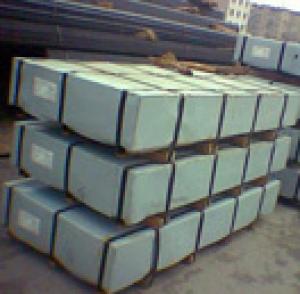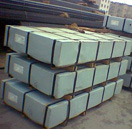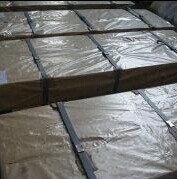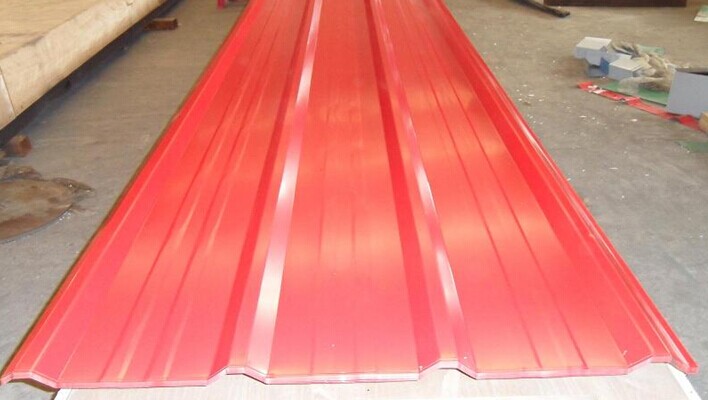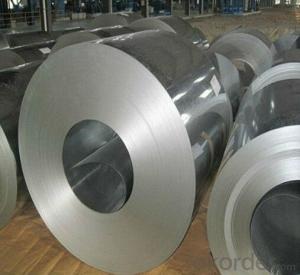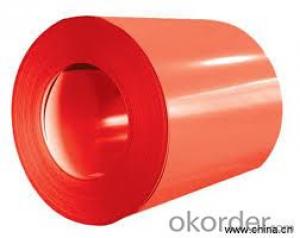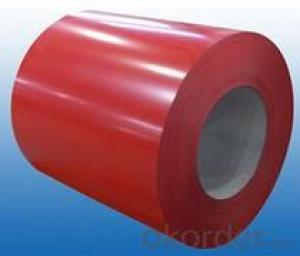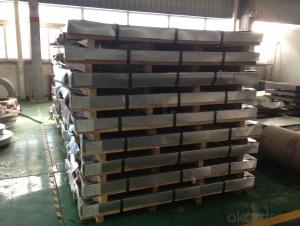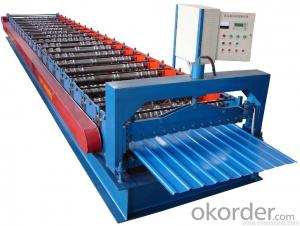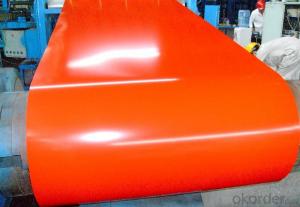Corrugated Prepaint Galvanized Steel Sheet
- Loading Port:
- China Main Port
- Payment Terms:
- TT OR LC
- Min Order Qty:
- -
- Supply Capability:
- -
OKorder Service Pledge
Quality Product, Order Online Tracking, Timely Delivery
OKorder Financial Service
Credit Rating, Credit Services, Credit Purchasing
You Might Also Like
Specifications
1.Commodity: Prime PPGI Corrugated Sheet
2.Size:0.135-0.6*600-1200mm*L
3.MOQ:20MT
Product Description
1.Commodity: Prime PPGI Roofing Sheet
2.Grade: CGCC.(Green/ Red, Z=40g/m^2)
3.Size: 0.135mm-0.6mm*600-1200mm*L
4.Quantity: 1000MT
5.Thickness tolerance: +0/-0.02mm
6.Width tolerance: +5/-0mm
7.Package: Mill's standard package (water proof paper+steel sheet cover+steel strips)
8.Shipment: Prompt (10-30 days)
9.Payment: TT/100% L/C at sight
- Q: How are steel coils transported and stored?
- Steel coils are typically transported using flatbed trailers, coil carriers, or railcars. These coils are securely strapped or banded to prevent movement during transportation. Once they reach their destination, they are usually stored in warehouses or outdoor storage yards. The coils are stacked on top of each other, often with the help of specialized equipment, to optimize space utilization. They may also be stored horizontally on racks or stored vertically in specially designed coil racks. Proper handling and storage procedures are followed to ensure the safety of personnel and to prevent damage to the steel coils.
- Q: Why is iron used to create steel? Why not other elements?
- iron came before steel. iron is what was discovered that, under certain circumstances, became a stronger metal: steel. that is why. its like asking why copper is in bronze. because what we call bronze, is an alloy of copper and tin. if you give a more detailed question, i may be able to give a more detailed answer.
- Q: What are the common methods of protecting steel coils from corrosion?
- There exist various techniques commonly employed for safeguarding steel coils against corrosion. 1. Coating: To establish a barrier between the steel coil and the corrosive environment, a protective coating can be expertly applied. Multiple types of coatings, including paint, epoxy, or zinc, are available, each possessing superb corrosion resistance and obstructing the ingress of moisture and oxygen onto the steel surface. 2. Hot-dip galvanizing: Immersing the steel coil in a bath of molten zinc constitutes the hot-dip galvanizing method, resulting in the formation of a substantial zinc coating. This zinc coating acts as a sacrificial barrier, effectively shielding the steel against corrosion. Hot-dip galvanizing is especially advantageous in harsh environments or when prolonged exposure to the outdoors is anticipated. 3. VCI (Volatile Corrosion Inhibitor) packaging: VCI packaging entails encasing the steel coils in specially designed film or paper laced with volatile corrosion inhibitors. These inhibitors vaporize and form a protective layer on the steel surface, effectively preventing corrosion. VCI packaging is commonly employed for short-term storage or transportation of steel coils. 4. Desiccants: Moisture plays a significant role in the corrosion process. Consequently, utilizing desiccants such as silica gel or activated alumina aids in moisture absorption and the maintenance of a dry environment surrounding the steel coils. Desiccants are often combined with other protective methods to enhance corrosion protection. 5. Appropriate handling and storage: Employing proper practices for handling and storage significantly mitigates the risk of corrosion. Steel coils should be stored in a dry environment, distanced from moisture sources. Additionally, clean gloves should be utilized during handling to prevent the transfer of corrosive contaminants. Regular inspection and maintenance of the storage area are crucial for identifying and addressing potential corrosion risks. By employing one or a combination of these methods, steel coils can be effectively preserved against corrosion, guaranteeing their longevity and structural integrity.
- Q: How do steel coils contribute to the energy storage industry?
- Steel coils contribute to the energy storage industry in several ways. Firstly, steel coils are used in the manufacturing of energy storage systems such as batteries. The steel casing provides structural support and protection to the battery cells, ensuring their safety and longevity. Without steel coils, the batteries would be more vulnerable to damage and would not be able to function effectively. Additionally, steel coils are essential in the construction of flywheels, which are another form of energy storage technology. Flywheels store energy by spinning a rotor at high speeds and then releasing the stored energy when needed. Steel coils are used to create the rotor, which needs to be strong, durable, and capable of withstanding the high rotational forces. The magnetic properties of steel also help to enhance the efficiency of energy transfer within the flywheel system. Furthermore, steel coils are used in the production of compressed air energy storage (CAES) systems. CAES systems store energy by compressing air and then releasing it to generate electricity when required. Steel coils are utilized in the construction of the air storage chamber, ensuring its integrity and preventing any leakage or damage. The robustness of steel coils makes them ideal for withstanding the high pressures involved in the compression process. In summary, steel coils play a crucial role in the energy storage industry by providing structural support, durability, and protection to various energy storage technologies. Whether it is in batteries, flywheels, or CAES systems, steel coils contribute to the efficient and safe storage of energy, helping to promote the development and adoption of sustainable energy solutions.
- Q: How are steel coils used in the manufacturing of agricultural sprayers?
- Steel coils are used in the manufacturing of agricultural sprayers primarily for constructing the frames, supports, and structural components of the sprayers. The high strength and durability of steel make it suitable for withstanding the harsh conditions and heavy loads associated with agricultural operations.
- Q: How long can steel coils be stored?
- Steel coils can be stored for an extended period if proper storage conditions are maintained. The duration of storage depends on factors such as coil quality, environmental conditions, and any specific storage requirements determined by the manufacturer.
- Q: This EN10025 S355JR is a European code for steel, of which the properties can be found here.
- Is bether to use this one below! ASTM A588/A588M. Standard Specification for High-Strength Low-Alloy Structural Steel with 50 ksi [345 MPa] Minimum Yield Point , Weather Resistant
- Q: What are the common problems faced during steel coil production?
- There are several common problems that can be encountered during steel coil production. One of the most common issues is coil breakage or damage. This can occur due to improper handling or transportation of the coils, which can lead to cracks or fractures. It is crucial to ensure proper handling procedures are followed to minimize the risk of coil breakage. Another common problem is coil slippage. This occurs when the coils are not securely stacked or stored, leading to them shifting or sliding. Coil slippage can result in damage to the coils and potentially cause accidents or injuries. Therefore, it is essential to have proper storage systems in place to prevent coil slippage. Additionally, coil corrosion is a common problem faced during steel coil production. Corrosion can occur due to exposure to moisture, air, or other corrosive substances. It can lead to the degradation of the steel, reducing its strength and durability. Implementing effective corrosion prevention measures, such as proper coating or storage techniques, is essential to mitigate this issue. Another challenge in steel coil production is coil quality issues. This can include inconsistent thickness, width, or surface defects on the coils. These quality problems can arise due to various factors, such as improper rolling processes, equipment malfunctions, or material defects. Regular quality checks and inspections should be conducted to identify and address any issues promptly. Moreover, coil handling and loading problems can also occur during steel coil production. Improper lifting or loading techniques can cause damage to the coils, leading to deformations or even accidents. It is crucial to train and educate employees on proper handling and loading procedures to prevent such problems. Overall, steel coil production can face various challenges, from coil breakage and slippage to corrosion and quality issues. Implementing proper handling, storage, and quality control measures is essential to minimize these problems and ensure the production of high-quality steel coils.
- Q: What are the environmental impacts of producing steel coils?
- The production of steel coils has numerous environmental effects. Firstly, it entails the extraction of iron ore, which necessitates mining activities. These mining operations can result in deforestation, habitat destruction, and soil erosion. Furthermore, considerable amounts of energy are required for the extraction and processing of iron ore, contributing to greenhouse gas emissions and air pollution. Moreover, the production of steel coils involves various stages, including smelting and refining, which are energy-intensive and release significant quantities of carbon dioxide, sulfur dioxide, and nitrogen oxides. These emissions contribute to air pollution, acid rain, and climate change. Water consumption is also a noteworthy environmental impact. Steel production necessitates substantial volumes of water for cooling and processing purposes. This high demand for water can strain local water resources and potentially lead to water scarcity or pollution if not managed properly. Furthermore, the steel industry generates substantial quantities of waste and by-products, such as slag, dust, and sludge. Proper disposal and treatment of these waste materials are crucial to prevent soil and water contamination. Lastly, transportation plays a role in the environmental impact of steel coil production. The transportation of raw materials and finished products can result in carbon emissions and air pollution, particularly for long distances. To mitigate these environmental impacts, various measures can be implemented. Adopting more efficient production processes, such as recycling and utilizing renewable energy sources, can reduce energy consumption and emissions. Additionally, enhancing waste management practices, investing in water conservation technologies, and optimizing transportation logistics can help minimize the environmental footprint of steel coil production.
- Q: exactly what is the differance between strontuim steel and stainless steel any differances as far as hardness .... need help.
- Strontium steel is created by soaking a mild steel in strontium chromate, which has a pH of about 4 or 5, roughly the equivalent of acid rain. Chromate affects the cathodic reaction, with reduction of Cr6+ to Cr3+, and the surface film was composed of magnetite and hydrated chromium hydroxide. The Strontium is a radioactive isotope. The acid bath permeates the mild steel causing it to become mildly radioactive. Simular to oil imprengation of brass and other metals. Strontium Steel has a very high value of inhibition. However due to it's radioactive properties it is not a commonly used or manufactured material. As for where to actually obtain Strontium steel dowels. I have no idea i would speculate that you would have to purchase the raw stock and have it machined into a dowel for you.
Send your message to us
Corrugated Prepaint Galvanized Steel Sheet
- Loading Port:
- China Main Port
- Payment Terms:
- TT OR LC
- Min Order Qty:
- -
- Supply Capability:
- -
OKorder Service Pledge
Quality Product, Order Online Tracking, Timely Delivery
OKorder Financial Service
Credit Rating, Credit Services, Credit Purchasing
Similar products
Hot products
Hot Searches
Related keywords
